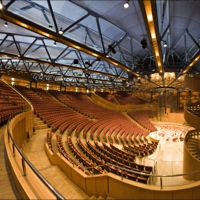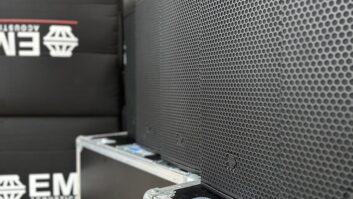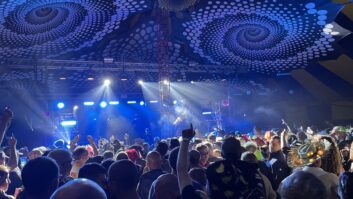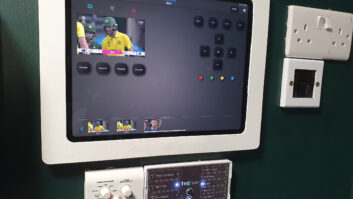
The Fourth Protocol by Frederick Forsyth may not actually be about the secrets of digital audio networking, but Phil Ward has some agents on the inside as he asks: why use one protocol over another?
Networked audio is the new rock and roll. Or at least it would be, if the pro-audio and installation community were ever to agree on which digital audio protocol was Elvis. The problem is that there are just too many impersonators.
That said, each protocol has its devotees and detractors and, although the dream of a universal standard continues to motivate the finest digital audio brains, the reality is that different techniques are finding favour in different quarters for differing reasons.
But first, what’s out there? Invented by sound engineers but now owned by semi-conductor mass producer Cirrus Logic, CobraNet has been the market leader in terms of licensees for many years. With CobraNet networked audio, any input can be routed by software to any output, using the IT data communications standard Ethernet. This is the basic goal: full remote control over the network and easy re-routing of audio without expensive cabling or separate analogue switching facilities. Switching is intrinsically provided by the network and protocol.
The challengers
The first serious challenge to CobraNet, EtherSound is also fully compliant with Ethernet standard IEEE 802.3, and in so doing takes full advantage of standard Ethernet cabling and components. Like CobraNet, in theory it helps to create networks using products from multiple vendors. Its stats speak of bidirectional, deterministic, very low-latency transmission of synchronised audio channels and control data through up to 64 channels of 24-bit/48kHz PCM audio, all alongside embedded control and monitoring data along a single cable. Higher sampling frequencies are possible by reducing the channel count, so as in all things digital there is a site-specific trade-off to be calculated.
New kid on the block Dante has been developed by Australian company Audinate. Another Ethernet-based offering, Dante similarly hopes to exploit standard IT network infrastructures to distribute digital media flexibly.
Optocore, from Germany, is the fibre-optic solution: a synchronous ring network of up to 64 audio channels with access to most other media and data formats.
Completing the picture are MADI and AES50, both broadcast and recording industry in origin but increasingly co-opted by sound reinforcement protagonists as the search for tried-and-tested solutions continues. Basically, installed systems are becoming so complex that any proven protocol will get a fair hearing in the right circumstances.
Rue or roll
Some appraise this technological tide ruefully. Ian Barfoot, a freelance sound engineer found frequently at FOH for caped keyboarder Rick Wakeman, presents the analogue view: “To be honest, the way the world is going you need a big fat network even on live jobs,” he reflects. “Just look at the number of control systems that need to be run! This includes not just the consoles but also the loudspeaker management software like Lake, Audiocore and Iris.”
Others are rolling with it, confidently. Kent-based SRD Group is a typical full-service pro-audio, lighting, power and events company increasingly drawn to installation work involving complex networks. Newly appointed as an Allen & Heath Service Centre, SRD uses the iLive console range to install into venues and as rental stock for live sound applications. MD Stuart Roberts says that the networking options make the desks more versatile and easier to install than their analogue counterparts.
“The ability to send audio over existing Ethernet networks enables configurations that would have been extremely expensive in the analogue, non-networked world,” he says. “One of the things we were looking for was a system using a protocol that is Ethernet/IP based and that will work with existing standard network switches and cabling.
We’ve found that both EtherSound and Allen & Heath’s ACE format work well across Layer 2 of Ethernet networks and switches. While we normally run the console to rack connection direct to minimise latency and prevent the possibility of accidental disconnection, the second, ‘B’ network connection – both with EtherSound and ACE – can be linked with other consoles and equipment to provide digital splits of the main desk inputs.
“This is not only useful for providing a monitor console with a split of the channels from the stage, but also allows the outputs of the desk to be sent over Ethernet straight to the amplifiers and processors, saving additional multicore cabling here too. EtherSound, with many compatible bits of kit already available, makes it possible to distribute audio around the building without the need for specialist cabling – so reducing the installation costs and making re-configuration a matter of simply adjusting the crosspoint routing matrix of the network from a laptop.”
In use
A good example might be a university campus theatre installation where there might be an iLive at FOH, which could either be connected at the back of the room for theatre-type shows or halfway down the auditorium for concerts. There would be two or more points at which the desk could be plugged in with a simple network patch next to an iDR Mix Rack to enable the house technician to choose the best position. There could also be another connection to patch to the main campus network via a virtual LAN, keeping the audio network segregated from the rest of the network and allowing EtherSound outputs downstream from the desk.
Scott Fraser is output product & audio network specialist at Yamaha Commercial Audio, and is familiar with all of the current Ethernet-based audio protocols. “Each has its own place,” he says, “and it really just depends on what you want to do. CobraNet, EtherSound and Dante all comply with the IEEE 802.3 standard, but vary in their compatibility with IT environments. You have to check carefully the details of how the audio packets are distributed, and compare them with each individual building before you make a choice.”
Fraser is currently completing an installation in London’s Westminster Abbey, its iconic and highly reverberant interior now enjoying networked audio thanks to CobraNet. “The main reason for CobraNet here is its dual-loop redundancy,” he explains. “Every CobraNet device is connected to a primary and a secondary network switch, and if something happens to the primary ring CobraNet automatically jumps to the second one. It jumps back at the next available point, getting you past any single point failure. Then there’s Multiple Spanning Tree (MST), which locates a virtual break in the ring to prevent continuous feedback – all of which is ideal for Westminster, because we’ve been able to protect the system from up to four points of failure and still have audio passing in all locations.”
High-spec system
Jörg ter Veer is sales & marketing manager at Audio Pro Heilbronn in Germany. Audio Pro specified a Soundcraft Vi6 system for the Philharmonic Hall in Cologne, networked via Optocore. At this level of budget, ter Veer says, the relatively more costly use of fibre optics makes perfect sense. “This is a ‘reference’ installation,” he says, “with a high spec of architecture and interior design as well as musical standards. The sound system needed to match this. The console was the centre-point of the decision, which led to the network. Crucially, it was a solution open to future investment and expansion – whatever the brand.”
DiGiCo was an early adopter of MADI and Optocore. MD James Gordon highlights the wider issue of having to second-guess market demand. “The real trouble is there is currently no strong demand for one single format,” he says, “and there are around 20 different options varying between transport systems to full control protocols. Some larger rental companies are discussing the newer network options but none are really certain which format to invest in. There is also growing concern about what the real cost of these formats will be. Most are charging manufacturers to adopt the format and then charging end users depending on the number of connections they use. This is a new style of charging to our industry and there is a real fear of the ongoing licensing costs.
“John Stadius and his team here have done a lot of behind-the-scenes research and our current position is to continue to monitor the situation until there is a clear winning format. DiGiCo will at that time implement the one that becomes the most relevant for our market sectors. It took MADI between 10 and 15 years to become a widely used format, and that one is free. The timeline will be shorter as digital is now the standard, but it’s still a consumer nightmare.”
Is it enough to put off installers completely? Phil Darke of UK-based Absolute Pro Audio simply can’t see an end to the claims and counter-claims. “I offer one network to a client, and they say surely there’s a better one on the way,” he rues. “It has really put me off, to be honest. You can select a protocol, and in a few years’ time there may be no hardware available that’s relevant to that protocol! But you can live without a digital audio network. In fact, I’ll actively avoid it.”
“It will be interesting to see what emerges as the dominant standard over the next few years,” reflects Roberts. “The main players at the moment are EtherSound, CobraNet and Dante. There are several other proprietary protocols available, but they generally don’t talk to each other and so are great for linking the same make of kit together but less useful as a general audio network system. The forthcoming IEEE 802 AVB standard will hopefully start to bring greater interoperability and compliance between systems, but if the IEEE Draft-N WiFi standard is anything to go by it could take some time before it becomes standard – and even then there will be no guarantee that each equipment manufacturer will implement it in the same way.”
www.audinate.com
www.audiopro.de
www.avab-cac.no
www.boschsecurity.com
www.cobranet.info
www.crestron.eu
www.digico.biz
www.meyersound.com
www.midasconsoles.com
www.optocore.com
www.srdgroup.co.uk
www.yamahacommercialaudio.com







